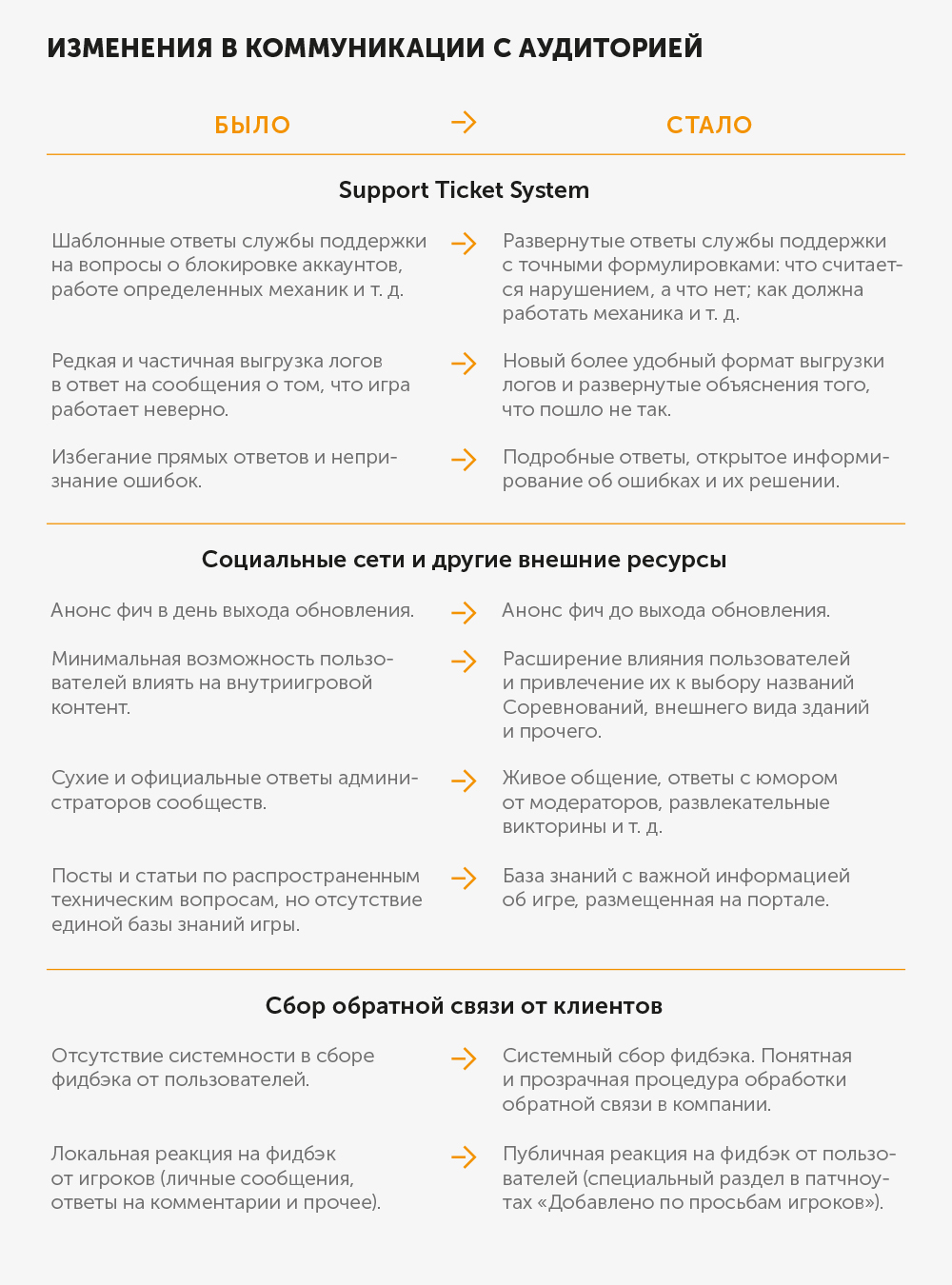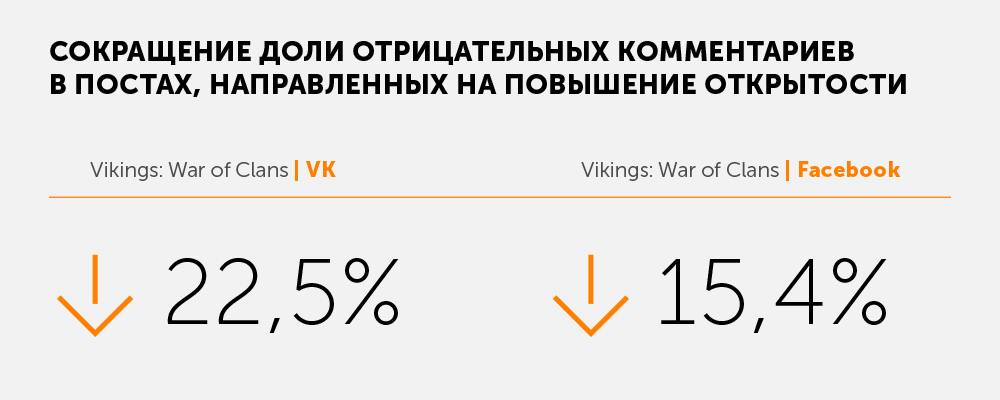Openness policy: how users influence the project
Information openness sometimes does more harm than good if the company and the audience are not ready for interaction. Telling players all about the product and giving them the opportunity to influence development is like walking on thin ice: there is a chance to fail. But if you learn to listen to the user and be honest with him, then increasing openness will positively affect not only the reputation, but also the projects themselves.

A year ago, employees of Plarium Krasnodar's Customer Experience & Support Division proposed a change in the way they communicate with users and provide them with information. Lead of Support Department Ivan Svintsov and Director of Community & Reputation Department Anna Zakharova talked about how good the new policy is and showed specific examples of how to improve interaction with the audience with its help.
An openness policy is not a decision that is made in one day in a hurry or “because I want it that way”. Before trying a new approach, evaluate the state of the product, the willingness of the company and users to an open dialogue, as well as the quality of feedback.
“At Plarium, everything was organically moving towards the adoption of a new concept,” recalls Ivan. - Players began to talk more with us on social networks. They were not interested in just writing a comment and forgetting about it. They wanted more sincere communication. ”
What are the benefits of information transparency in our company? The guys from the Customer Experience & Support Division asked themselves this question in the first place and decided that a new approach would help:
“We have already done a lot of work to collect offers from players, monitor mood in social networks, create useful content. But we decided to go further and began to think about how to make our work even better, ”says Anna.
Analysis of the target audience is very important before making any decision regarding users. Therefore, the employees of CE&S Division first of all did a lot of research and found out what the players want to hear and what the company is ready to say.
After reviewing cases of other developers, the guys made conclusions and realized how to interact with the audience, and what is better to avoid.
The new policy required changes in the workflow, so an important step in the preparation was the restructuring of communications between the teams, departments and departments of the company. Indeed, if their work is not synchronized, it will turn out like in a fable about a swan, pike and cancer - the cart will remain in place.
“When the management approved the concept, we did not shock our players with a thousand news. We expanded the boundaries a little bit, but every month, ”says Ivan.
The new policy has changed all communication with the audience - from posts on social networks to support responses. Thus, a huge work has been done over the year.
The table below shows examples of changes in communication with users of the game Vikings: War of Clans.

“We do not strive for complete information transparency,” says Anna. “At the preparation stage, when we analyzed international experience, we realized that many things should not be tried, no matter how noble they may seem.”
The guys examined several cases to warn against the mistakes of those who would follow the path of openness.
Case 1
The developer encourages users to write about all bugs found in the discussions on the company page.
Result: The official community turns into a thrash tape. Moreover, in most cases, players mistake mechanics or complex features for bugs in games. Moderators cannot give everyone a detailed answer, because they do not keep up with everything that users write. Those, in turn, do not get the right information at the right time, and the negative is growing. New players are scared away by a large number of "bugs".
Solution: use social networks not to track errors, but to give subscribers useful information about mechanics and new features.
Case 2
The developer reports any problem in the game.
Result: “The growth of negative is inevitable if you make a post about every local failure. The players, as soon as they see that there is a problem, begin to pour questions, not even figuring out whether this case concerns them or not, ”comments Anna. As a result, not only user dissatisfaction is growing, but also the load on support specialists, as they check each request.
Solution: support service should work with local situations. “Communicating individually with each user,” adds Ivan, “we can collect more information about the problem, which means we will solve it faster and more efficiently.”
Case 3
Upcoming updates are described in advance and in detail in social networks.
Result: “Development is a complex process, and often how a company sees a feature at the beginning changes by the time it is implemented,” Anna shares her experience. - As a result, if we talked about a feature before its release, and then something changed, the user feels cheated. Confidence in the company is falling. ”
Solution: work with other departments to work out a list of topics that can be covered on external resources without risking deceiving user expectations.
Plarium Experience
“When we started writing about updates long before the release of a new feature, we came across an interesting phenomenon,” Anna recalls. - Users thought that since we are writing now, the update will be released today, tomorrow, or a maximum in a week. Their impatience turned into annoyance, and they increasingly turned to the community service with questions, "Well, when?" To adjust the expectations of the audience, we began to inform whenever possible when the update is planned. For the announcement, we chose a time that would be convenient for both the company and users. ”
Based on the results of monitoring social networks and the work of the support service for January – May 2019, the guys from CE&S Division summarized the following openness policy results:

CE&S Division employees are confident that through an openness policy, they have been able to build constructive relationships with users. Players feel part of the development, and the company receives a useful feedback from them.
No matter how inspiring the outcome of an openness policy may be, it is sometimes difficult to follow. Anna and Ivan shared principles that will help those who are introducing a new approach to work:

A year ago, employees of Plarium Krasnodar's Customer Experience & Support Division proposed a change in the way they communicate with users and provide them with information. Lead of Support Department Ivan Svintsov and Director of Community & Reputation Department Anna Zakharova talked about how good the new policy is and showed specific examples of how to improve interaction with the audience with its help.
When to change something
An openness policy is not a decision that is made in one day in a hurry or “because I want it that way”. Before trying a new approach, evaluate the state of the product, the willingness of the company and users to an open dialogue, as well as the quality of feedback.
“At Plarium, everything was organically moving towards the adoption of a new concept,” recalls Ivan. - Players began to talk more with us on social networks. They were not interested in just writing a comment and forgetting about it. They wanted more sincere communication. ”
Why do all this
What are the benefits of information transparency in our company? The guys from the Customer Experience & Support Division asked themselves this question in the first place and decided that a new approach would help:
- improve user experience;
- increase the share of positive comments in social networks;
- increase the effectiveness of customer experience management;
- increase the involvement of the audience both in the game and in communication with the company.
“We have already done a lot of work to collect offers from players, monitor mood in social networks, create useful content. But we decided to go further and began to think about how to make our work even better, ”says Anna.
Where to begin
Analysis of the target audience is very important before making any decision regarding users. Therefore, the employees of CE&S Division first of all did a lot of research and found out what the players want to hear and what the company is ready to say.
After reviewing cases of other developers, the guys made conclusions and realized how to interact with the audience, and what is better to avoid.
The new policy required changes in the workflow, so an important step in the preparation was the restructuring of communications between the teams, departments and departments of the company. Indeed, if their work is not synchronized, it will turn out like in a fable about a swan, pike and cancer - the cart will remain in place.
What has changed in Plarium
“When the management approved the concept, we did not shock our players with a thousand news. We expanded the boundaries a little bit, but every month, ”says Ivan.
The new policy has changed all communication with the audience - from posts on social networks to support responses. Thus, a huge work has been done over the year.
The table below shows examples of changes in communication with users of the game Vikings: War of Clans.

What to fear
“We do not strive for complete information transparency,” says Anna. “At the preparation stage, when we analyzed international experience, we realized that many things should not be tried, no matter how noble they may seem.”
The guys examined several cases to warn against the mistakes of those who would follow the path of openness.
Case 1
The developer encourages users to write about all bugs found in the discussions on the company page.
Result: The official community turns into a thrash tape. Moreover, in most cases, players mistake mechanics or complex features for bugs in games. Moderators cannot give everyone a detailed answer, because they do not keep up with everything that users write. Those, in turn, do not get the right information at the right time, and the negative is growing. New players are scared away by a large number of "bugs".
Solution: use social networks not to track errors, but to give subscribers useful information about mechanics and new features.
Case 2
The developer reports any problem in the game.
Result: “The growth of negative is inevitable if you make a post about every local failure. The players, as soon as they see that there is a problem, begin to pour questions, not even figuring out whether this case concerns them or not, ”comments Anna. As a result, not only user dissatisfaction is growing, but also the load on support specialists, as they check each request.
Solution: support service should work with local situations. “Communicating individually with each user,” adds Ivan, “we can collect more information about the problem, which means we will solve it faster and more efficiently.”
Case 3
Upcoming updates are described in advance and in detail in social networks.
Result: “Development is a complex process, and often how a company sees a feature at the beginning changes by the time it is implemented,” Anna shares her experience. - As a result, if we talked about a feature before its release, and then something changed, the user feels cheated. Confidence in the company is falling. ”
Solution: work with other departments to work out a list of topics that can be covered on external resources without risking deceiving user expectations.
Plarium Experience
“When we started writing about updates long before the release of a new feature, we came across an interesting phenomenon,” Anna recalls. - Users thought that since we are writing now, the update will be released today, tomorrow, or a maximum in a week. Their impatience turned into annoyance, and they increasingly turned to the community service with questions, "Well, when?" To adjust the expectations of the audience, we began to inform whenever possible when the update is planned. For the announcement, we chose a time that would be convenient for both the company and users. ”
Summary
Based on the results of monitoring social networks and the work of the support service for January – May 2019, the guys from CE&S Division summarized the following openness policy results:
- Help for players has reached a new level. Due to the change in the format for submitting logs, the number of related positive calls increased by 2 times, and the average number of iterations decreased from 2.9 to 2.7.
- The audience has become more tolerant of the problems arising in the game and discussing them in a more neutral manner. On social networks, the percentage of negative comments in posts aimed at increasing openness has significantly decreased (by 22.5% on VK and 15.4% on Facebook).
- User loyalty has grown. The more open answers of the developer and the recognition of his mistakes caused the approval of the players. The total number of calls to the support service with a positive tone increased by almost 10 times, and with a negative tone, it decreased by 7 times. The average rating for Support increased from 1.66 to 4.25.
- The audience has become more involved in the process of discussing new features. The average number of comments under one post increased in VK and FB by about 57%.

CE&S Division employees are confident that through an openness policy, they have been able to build constructive relationships with users. Players feel part of the development, and the company receives a useful feedback from them.
Advice
No matter how inspiring the outcome of an openness policy may be, it is sometimes difficult to follow. Anna and Ivan shared principles that will help those who are introducing a new approach to work:
- Experiment and be persistent. It takes a lot of perseverance to prove the benefits of the new user communication policy and to rebuild work processes in accordance with this.
- Follow the trends. Learn both the positive and negative experiences of other companies.
- Analyze your work and approaches. Do not rely only on your feelings.
- Consider the risks and opportunities: what the audience is ready for, in what condition the product is, whether the company can restructure processes.
- Do not be afraid of your users. They really have a lot of useful ideas.
- Be open yourself to listen and hear feedback.
All Articles